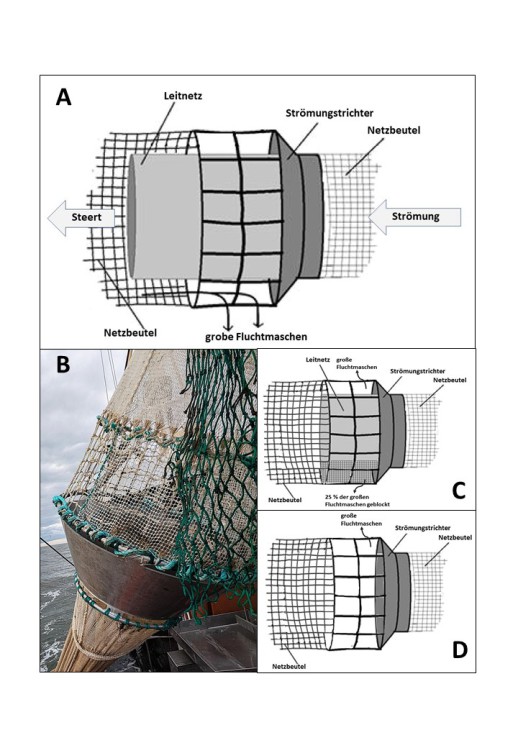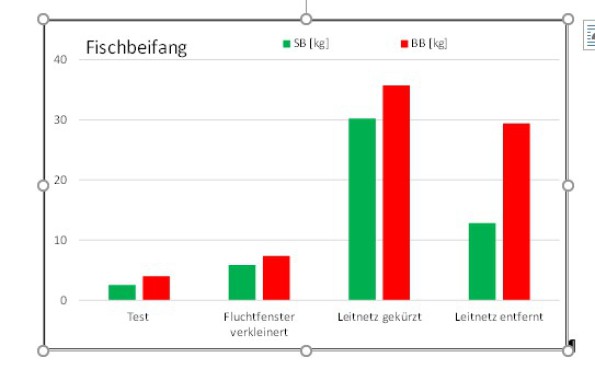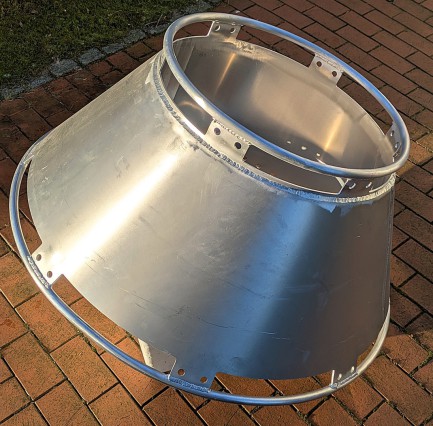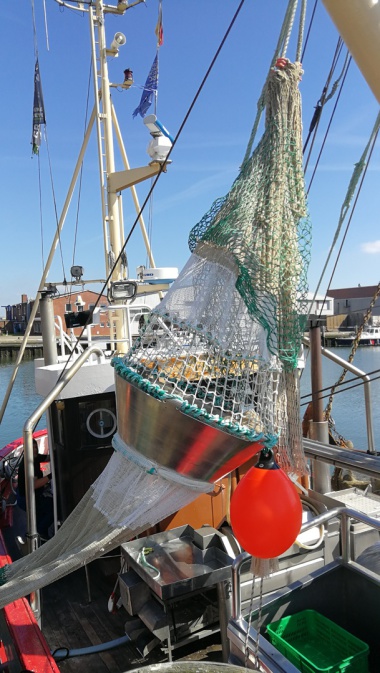MiniFish - Project completed
(Status: October 2025)
After a two-year research phase, the project “MiniFisch – Bycatch Reduction in Brown Shrimp Fisheries” has been successfully completed. The initiative, funded by the State of
Schleswig-Holstein and the European Union, aimed to significantly reduce fish bycatch in brown shrimp fisheries without substantially affecting the catches of marketable shrimp.
The results demonstrate that the flow funnel developed within the project achieved an average reduction in fish bycatch of 56 per cent. This outcome highlights the potential of technical innovation
to enhance the ecological sustainability of the brown shrimp fishery.
Function of the Flow Funnel
The bycatch reduction device was adapted from an original concept developed by fisheries researchers in the United States to the specific conditions of the North Sea. Its operation is based on the controlled modification of water flow inside the trawl: immediately behind the funnel, current velocity decreases. Fish detect this change through their lateral line organ and actively move into the areas of reduced flow, where they can escape through larger mesh openings.Brown shrimp, in contrast, do not perceive this change and continue following the main current towards the codend.
Field Trials under Commercial Conditions
To test the device under realistic fishing conditions, 86 hauls were conducted in the fishing grounds around Büsum. The trials were carried out on board the fishing vessel “Maret” (SC 14) under
the direction of Jan Möller, supported by his crew and senior fisherman Rainer Möller.
The field phase took place under partly challenging environmental conditions. In 2024, an unusually long-lasting invasion of whiting (Merlangius merlangus) occurred in the Wadden Sea,
accompanied by very low shrimp abundances. This situation complicated both data collection and evaluation. Nevertheless, robust and representative results were obtained.
Optimisation of Gear Configuration
Throughout the project, various configurations of the flow funnel were tested. The main variables were the length of the inner guiding net and the size of the escape openings. The objective was to achieve the highest possible reduction in fish bycatch while maintaining stable shrimp catches.
Sketch A) shows the flow funnel (dark grey) in the original setup with a 1.5 m long guide net and 10 cm escape windows; photo B) shows the escape windows reduced by 25% and sketch C) shows the guide net shortened to 80 cm. Sketch D) shows the optimised setting without a guide net and with 10 cm escape windows.
The most effective configuration consisted of a setup without a guiding net and with 10 cm escape meshes. Under these conditions, fish bycatch was reduced by an average of 56 %. The most pronounced reductions were observed in pelagic fish species such as herring (–63 %), smelt (–50 %) and whiting (–51 %). These species are particularly sensitive as they generally do not survive capture and handling on board.
In addition, the use of the flow funnel led to a 14 % decrease in species diversity within the bycatch. A reduced number of non-target species in the catch indicates improved selectivity of the fishing method and supports the goal of preserving biodiversity in the Wadden Sea.
Further Potential for Improvement
In the configuration that achieved the greatest reduction in bycatch, a decrease of approximately 30 % in marketable shrimp catches was recorded. Such losses are currently too high for economic viability. However, there remains considerable potential for optimisation. Future adjustments, particularly with respect to the mesh size of the escape windows and the design and length of the inner guiding net, may allow for a more balanced compromise between ecological effectiveness and economic feasibility.These refinements are intended to be evaluated in a possible follow-up project.
Contribution to a Sustainable Brown Shrimp Fishery
The MiniFisch project demonstrates that technical innovations in fishing gear can make a measurable contribution to marine conservation without fundamentally questioning the fishing practice
itself. The flow diverter offers a practical approach to significantly reducing bycatch, enhancing biodiversity protection and further strengthening the sustainability of brown shrimp
fisheries.
Successful implementation will depend on close cooperation between research institutions and the fishing industry. Only through constructive dialogue with fishing companies can technical solutions be
developed that meet both ecological requirements and economic realities.





